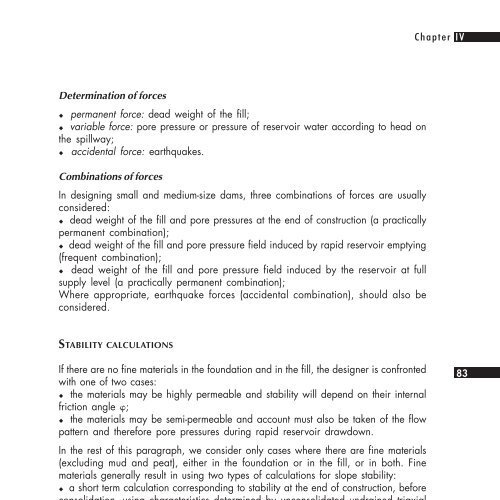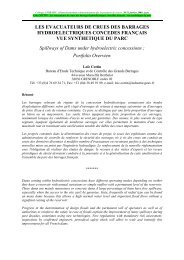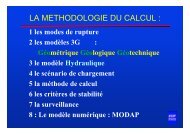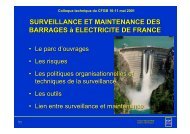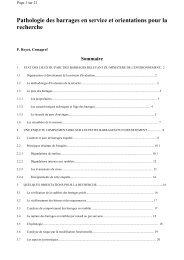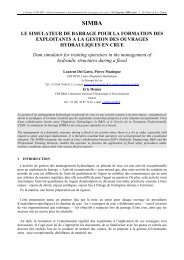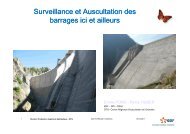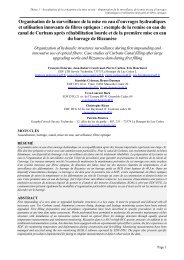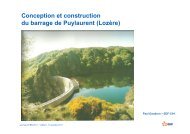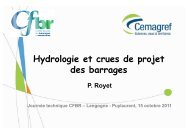SMALL DAMS
SMALL DAMS - Comité Français des Barrages et Réservoirs
SMALL DAMS - Comité Français des Barrages et Réservoirs
- No tags were found...
You also want an ePaper? Increase the reach of your titles
YUMPU automatically turns print PDFs into web optimized ePapers that Google loves.
Chapter IV<br />
Determination of forces<br />
!" permanent force: dead weight of the fill;<br />
!" variable force: pore pressure or pressure of reservoir water according to head on<br />
the spillway;<br />
!" accidental force: earthquakes.<br />
Combinations of forces<br />
In designing small and medium-size dams, three combinations of forces are usually<br />
considered:<br />
!"dead weight of the fill and pore pressures at the end of construction (a practically<br />
permanent combination);<br />
!"dead weight of the fill and pore pressure field induced by rapid reservoir emptying<br />
(frequent combination);<br />
!" dead weight of the fill and pore pressure field induced by the reservoir at full<br />
supply level (a practically permanent combination);<br />
Where appropriate, earthquake forces (accidental combination), should also be<br />
considered.<br />
STABILITY CALCULATIONS<br />
If there are no fine materials in the foundation and in the fill, the designer is confronted<br />
with one of two cases:<br />
!" the materials may be highly permeable and stability will depend on their internal<br />
friction angle ;<br />
!" the materials may be semi-permeable and account must also be taken of the flow<br />
pattern and therefore pore pressures during rapid reservoir drawdown.<br />
In the rest of this paragraph, we consider only cases where there are fine materials<br />
(excluding mud and peat), either in the foundation or in the fill, or in both. Fine<br />
materials generally result in using two types of calculations for slope stability:<br />
!"a short term calculation corresponding to stability at the end of construction, before<br />
consolidation, using characteristics determined by unconsolidated undrained triaxial<br />
tests interpreted with consideration of total stresses;<br />
!"a long-term calculation after consolidation and after a rapid drawdown operation 1<br />
for the upstream slope, considering effective stresses using the characteristics determined<br />
by the consolidated undrained (or drained test in some cases) triaxial test.<br />
Calculation methods for circular failure modes such as the FELLENIUS or BISHOP<br />
methods (the FELLENIUS method being the more pessimistic) are suitable in routine<br />
cases. Methods for non-circular failure modes such as the SPENCER method should<br />
be used for some zoned dams and when the foundation is partially (in one layer) or<br />
totally made up of weak materials.<br />
83<br />
1. The calculation in "rapid drawdown conditions" is done assuming that emptying is instananeous,<br />
which is not very far from reality.


